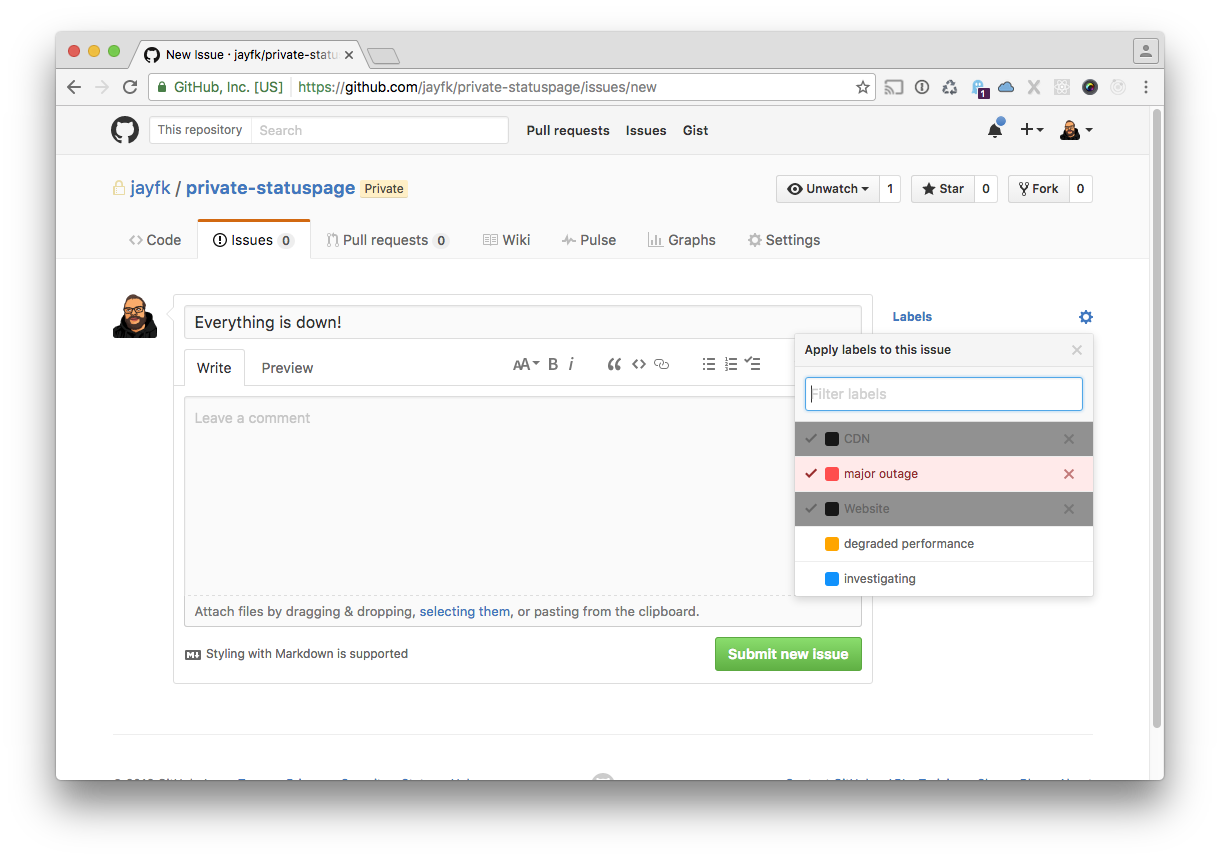We are currently alpha-testing a fully automated statuspage GitHub app. Check out corestatus.io if you like to test it out.
Statuspage
A statuspage generator that lets you host your statuspage for free on GitHub. Uses issues to display incidents and labels for severity.
Demo
See a real status page generated by this here demo site
Quickstart
Install statuspage with pip:
pip install statuspage
There are also binaries for macOS and Linux available, see installation for more.
Now, create an GitHub API token:
- Go to your Personal Access tokens page.
- Click on
Generate new token. - Make sure to check the
public_repoandwrite:repo_hookscope. - Copy the token somewhere safe, you won't be able to see it again once you leave the page.
To create a new status page, run:
statuspage create --token=<yourtoken>
You'll be prompted for a repo name and the systems you want to show a status for.
Name: mystatuspage
Systems, eg (Website,API): Website, CDN, API
Please note: This will generate a new repo under that name. Make sure it doesn't exist already.
The command takes a couple of seconds to run. Once ready, it will output links to the issue tracker and your new status page.
Create new issues at https://github.com/<login>/mystatuspage/issues
Visit your new status page at https://<login>.github.com/mystatuspage/
The generator will then print the statuspage update command filled with all the details you need to update your page.
Create an issue
To create a new issue, go to your newly created repo and click on New Issue.
- Click on the cog icon next to labels on the right.
- Choose the affected systems (black labels)
- Choose a severity label (major outage, degraded performance, investigating)
- Fill in the title, leave a comment and click on
Submit new issue.
Now, update your status page. Go back to your commandline and type:
statuspage update --token=<yourtoken>
Name: mystatuspage
If you change the issue (eg. when you add a new label, create a comment or close the issue), you'll
need to run statuspage update again.
Adding and removing systems
In order to add or remove a system, run:
statuspage add_system --token=<token> --name=<repo> --system=<system to add>
statuspage remove_system --token=<token> --name=<repo> --system=<system to remove>
Upgrading from previous versions
First, install the latest version with pip, or grab the latest binary:
pip install statuspage --upgrade
Updating your page to the latest version is now as simple as running:
statuspage upgrade --token=<token> --name=<repo>
followed by an update:
statuspage update --token=<token> --name=<repo>
Translations
The generated status page is translated via JavaScript on the client side using webL10n. It detects the visitors preferred language and translates all strings automatically.
Translations are available for the following languages:
- en
- de
- nl
- pt
- es
- ru
- fr
- pl
Want to add a translation? Open translations.ini and add it. Pull requests welcome!
Customizing
Want to change styles, the logo, or the footer? Check out customizing.
Options
Want to create a status page for an organisation, or a private one? See options.

